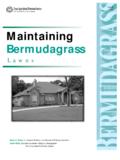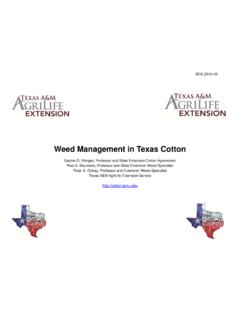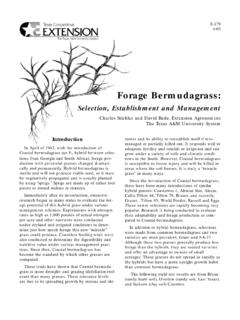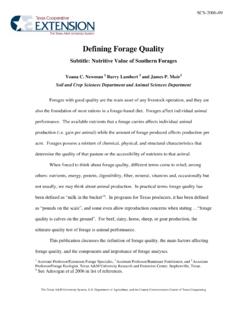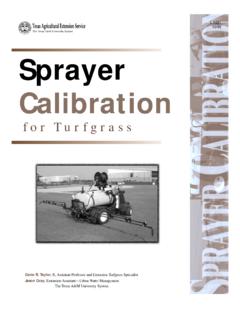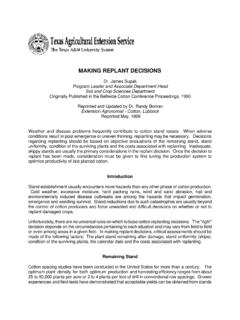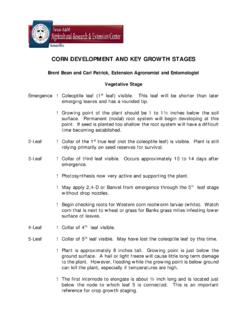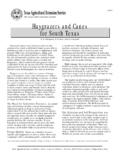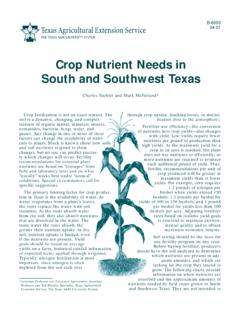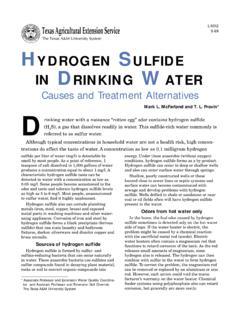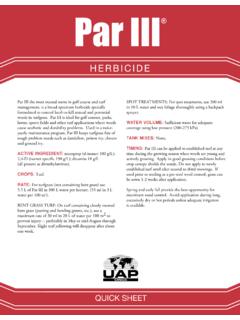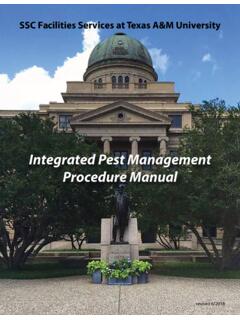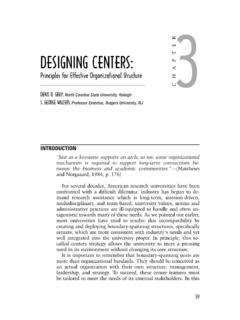Transcription of Maintaining St. Augustinegrass
1 Gene R. Taylor II, Assistant Professor and Extension Turfgrass SpecialistJason Gray, Extension Assistant Turfgrass ManagementThe Texas A&M University SystemMaintainingSt. AugustinegrassLawnsL-534011/99St. Augustinegrass (Stenotaphrum secundatum[Walt.]Kuntze) is a popular warm-season turfgrass for home is found in the United States, southern Mexico, SouthAmerica, South Africa, western Africa, the Caribbean, theHawaiian Islands, Australia and the South Augustinegrass is medium to dark green and coarsetextured, and it has a low, dense growth habit. It grows wellin nearly all soil types and tolerates shade, heat, salt and, tosome degree, drought. It does not tolerate waterlogged soilsor extended periods of cold weather. St. Augustinegrass is anaggressive species that spreads rapidly by above-groundgrowth structures called stolons.
2 If managed properly, forms a dense cover that handles light trafficand competes well with most weeds. St. Augustinegrass isthe most shade tolerant warm-season Common, Raleigh, Seville, Palmetto and Floratamare St. Augustine varieties commonly used for home lawns inthe southern United States. Each variety has characteristicsthat make it best in certain situations. Contact your countyExtension agent for information on the variety best suited foryour keep your St. Augustinegrass lawn in good condition,follow these guidelines for mowing, watering and fertilizing,as well as for controlling weeds, insects, thatch, andeliminating compacted soil. Because many factors affect turfgrowth, these are general through MayMowingBegin a routine mowing program as soon as the grassbegins to turn green in the spring. Remove no more thanone-third of the leaf area with any one mowing.
3 Set themowing height at 21/2to 3 inches (3 to 31/2inches in shadylawns). The lower the mowing height, the more frequentlyyou will need to mow. Frequent mowing at a lower heightproduces higher quality is best not to bag grass clippings. Grass clippingsdecompose quickly and return significant amounts ofnutrients to the soil. If you do bag the clippings, considercomposting them for use in the fertilizing 3 weeks after the grass turns green andwhen there is little chance of a late frost. Apply 1 pound ofsoluble nitrogen per 1,000 square feet of lawn every 8 weeks,or 11/2pounds of slow-release nitrogen every 10 your soil tested to determine what added nutrientsyour lawn may need. For information on soil testingprocedures, contact your county Extension you do not have the soil tested, use a complete fertilizerwith a 3-1-2 ratio of nitrogen, phosphorus and potassium(Examples: 15-5-10, 21-7-14, etc.)
4 Every bag of fertilizer hasthe nutritional analysis printed on the bag).To determine the amount of fertilizer needed to equal 1pound of nitrogen per 1,000 square feet, divide 100 by thefirst number in the fertilizer analysis. For example, if youare using a 15-5-10 fertilizer, then you need pounds per1,000 square feet. (To determine the amount needed to apply11/2pounds per 1,000 square feet, substitute 150 for 100.)100 15 = determine the size of the area to be fertilized. Ifyour lawn is 5,000 square feet, you will need 33 pounds of15-5-10 fertilizer.(5,000 1,000) x = 33 pounds of fertilizerWateringTo keep your lawn healthy, water it only when the grassneeds it. When you do water, wet the soil to a depth of 6inches. Then don t water again until the grass showssymptoms of drought stress a dull, bluish color, rolled orfolded leaves, and persistent footprints.
5 This usually occursin 5 to 10 days, depending on the these steps to determine how long to water toapply the right out five or six open-top cans randomly around the lawn (tuna or cat food cans work best). on the sprinklers or irrigation system for 30 a ruler, measure the depth of water caught in each individual can, and record the the average depth of water of all the :You have placed five cans in your yard. The depths of water in the cans were inch, inch, inch, inch and inch. Add the depths together and divide by the number of cans you + + + + = inches 5 cans = inch of water in 30 minutesNew-style irrigation controllers allow you to water several times a day, so you can program them to prevent a garden spade or a soil probe to find out how deeply the soil was wet during the 30-minute period.
6 The probe will push through wet soil easily, but it is more difficult to push through dry proper maintenance,you can help keepyour St. Augustinegrass lawn healthy and attractive. St. Augustinegrass spreads by above-ground growth structures called you know how much water was applied in 30 minutes and how deeply that volume of water wet the soil, then determine how long you must water to wet the soil to a depth of 6 :If the sprinklers sprayed 1/2inch of water in 30 minutes and wet the soil to a depth of 3 inches, you would need to apply 1 inch of water to wet the soil to a depth of 6 inches. To do so you must water for 1 from watering a lawn can waste asignificant amount of water, which is costly anda poor use of a limited natural resource. Thefactors determining how quickly run-off occursare the type of soil and the application rate ofthe sprinkler system.
7 Do not apply water fasterthan the soil can absorb it. To prevent run- the lawn while watering. If water begins running into the streets or gutters, note how long it took before run-off occurred. This is the maximum amount of time you should water at one watering and allow the soil surface to dry (30 minutes to 1 hour). watering again and continue for the time you ve determined. With an automaticirrigation system, change your timer to the new, shorter this cycle until the appropriate amount of water has been applied to wet the soil to a depth of 6 weedsThe best form of weed control is a healthy,dense, actively growing lawn. To controlcrabgrass and other grassy weeds, applypreemergent herbicides (which control weedsbefore they sprout from the ground) in thespring when soil temperature reaches 65 F orwhen the redbud and dogwood trees begin tobloom.
8 Apply postemergent herbicides (whichcontrol weeds that have already sprouted) asneeded. Apply herbicides only when weeds arepresent, and when the grass is healthy andactively control is most effective if you applythe herbicide when the weeds are still very Augustinegrass is very sensitive to someherbicides, such as 2,4-D. Read the labelcarefully before applying any herbicide to ensurethat it is the right product for the weeds you haveand that you do not damage the turf . Follow allinstructions on the label. It explains how andwhen to use the product and how much to insectsChinch bugs and white grubs are the twomost serious insect pests in St. Augustinegrasslawns. Routinely check for these pests and treatas necessary. (See L-1766, Chinch Bugs in Lawns, and L-1131, White Grubsin Texas Turfgrass, available from the TexasAgricultural Extension Service.)
9 Controlling thatchIf the thatch layer (a layer of undecomposedplant matter) is more than 3/4inch thick, mowthe lawn with a vertical mower or scalp thelawn (cut with a rotary mower at its lowestsetting) in April or May when the grass ishealthy and actively compacted soilIn areas of heavy traffic, aeration can helpeliminate compacted soils. Use a core-aeratingmachine when the grass is actively growing. Ifyou have an underground irrigation system, flagthe sprinkler heads first to avoid damaging SeptemberMowingFollow the same recommendations as forMarch through the fertilizer program begun in thespring, applying 1 to 11/2pounds of nitrogen per1,000 square feet every 8 to 10 weeks. Withoutsoil test information, it is recommended thatyou use a fertilizer that either contains nitrogenonly (21-0-0, ammonium sulfate) or is low inphosphorus (Examples: 21-3-6 or 15-0-15) toreduce the chance of excessive phosphorusFrequent mowing at a low mowing height produces a higherquality by Agricultural Communications, The Texas A&M University SystemExtension publications can be found on the Web at: programs of the Texas Agricultural Extension Service are open to all people without regard to race, color, sex, disability, religion, age or national in furtherance of Cooperative Extension Work in Agriculture and Home Economics, Acts of Congress of May 8, 1914, as amended, and June 30, 1914,in cooperation with the United States Department of Agriculture.
10 Chester P. Fehlis, Deputy Director, Texas Agricultural Extension Service, The Texas A&MUniversity M, NewTURF 4build-up in the soil. Such build-ups can lead to deficienciesin iron and prevent yellowing caused by iron chlorosis, applyliquid or granular iron fertilizer throughout the growingseason. Follow the label directions for the rate of appli-cation. Fertilizers containing iron may stain concrete, brickor stone the same recommendations as for March weedsContinue applying postemergent herbicide as containing 2,4-D should be used with care, as is sensitive to this herbicide. Herbicides maydamage the lawn if you apply them when the temperature ishigher than 90 insectsFollow the same recommendations as for March throughMay. The most effective time to treat for white grubs is inAugust when they are immature and close to the soil compacted soilsFollow the same recommendations as for March FebruaryMowingContinue the recommended mowing practices until thegrass goes dormant and does not require fertilizing as recommended until 4 to 6 weeksbefore the first expected frost.
